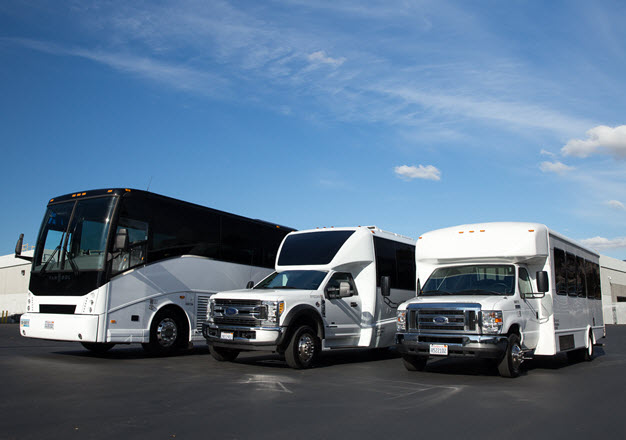Here are 10 tips on capacity and vehicle selection for employee shuttle transportation:
1. Evaluate Employee Transportation Needs
Begin by assessing your entire employees. Determine the number of employees who will utilize the shuttle service on a regular basis. Consider factors such as the number of employees, their working schedules and the high-traffic hours. These details will assist you in determining the capacity of your vehicle and make sure that shuttles can accommodate a variety of passengers numbers.
2. Select the appropriate vehicle type
Choose the best vehicles suitable for your shuttle service according to the number of employees employed and particular requirements. Vans and minibuses are both viable options. Minibuses are suitable for small groups, and they can navigate through tighter space. The larger buses are ideal for large groups. If employees are travelling with luggage or bags, consider the layout of the car and whether it is equipped with comfortable seating.
3. Evaluate Fuel Efficiency
The price of fuel could be a significant factor in the budgeting for shuttle services. Make sure to choose fuel-efficient vehicles in order to cut down on operating costs. Think about hybrid and electric vehicles too, since they are more durable and can save you money in the long term. It is important to compare the efficiency of each model so that you can make an informed choice that balances cost-effectiveness and capacity.
4. Consider Accessibility Features
Ensure that selected vehicles comply with accessibility requirements to accommodate employees with disabilities. It is a must to include features such as wheelchair lifts, lower floors to make it easier for those with mobility issues to use the vehicle and special seating designated for those with mobility issues. Accessible transportation does not only meet the law and promotes an inclusive working environment.
5. Plan for Growth & Flexibility
The size of the workforce could change with the growth of organizations. When selecting vehicles, take into account the possibility of expansion in the near future. Making investments in vehicles that have flexibility in seating configurations as well as the option to increase capacity will allow you to change the number of employees you employ without having to replace your vehicle frequently.
6. Review safety ratings and features
Safety is a priority in the transport of employees. Research the vehicle's safety rating and specifications before purchasing it. Look for cars with the most sophisticated safety features, such as antilock brakes and stability control. Also, check whether all safety regulations are being adhered to by the vehicle to protect employees during travel.
7. Assessment of Maintenance and Reliability
Select cars that are well-known for their low maintenance cost and reliability. A vehicle that requires frequent repairs could cause interruptions in shuttle service and employee dissatisfaction. Also, you can develop a maintenance schedule to maintain vehicles in optimal condition and extend their longevity.
8. GPS and Fleet Management Software
The shuttle service you provide can increase efficiency by using GPS tracking and fleet software. These programs allow for real-time tracking of the location of vehicles and optimise routes in accordance with the conditions of traffic, employee schedules and employee schedules. Additionally, using software to manage fleets can assist monitor vehicle performance in terms of fuel consumption, as well as maintenance needs, ensuring that vehicles are being used effectively.
9. Implementing Feedback Mechanisms for Employees
Surveys or suggestion boxes can be used to encourage employees to provide feedback regarding the comfort of their vehicles. Knowing their experiences will help identify any issues with the seating, comfort of the seats, or accessibility. Monitoring this feedback frequently will allow for needed adjustments to the choice of vehicle and service changes.
10. Budget for Total Cost of Ownership
When choosing a car, you must take into consideration the total cost of ownership (TCO) which includes cost of purchase and fuel costs, as well as insurance maintenance and depreciation. TCO analysis allows for informed decisions that balance initial investment with operational costs over the long-term. It is possible to make educated decisions by weighing all the costs involved. This will allow you to choose a vehicle which meets your financial requirements while providing capacity and reliability.
Follow these tips to ensure that your organization can select the right vehicle and manage the capacity of employee shuttles. View the top rated employee shuttle info for more recommendations including sfo airport transportation, airport shuttle from airport, shuttle bus, van transportation, car services lax airport, shuttle for the airport, sfo airport shuttle, airport shuttle service, airport bus shuttle, reliable transportation and more.

10 Top Tips On Customer Service & Communication For Corporate Event Transportation Services
Here are 10 top tips to improve customer service for corporate event transportation services.
1. Create a Transportation Coordinator
Affect a dedicated coordinator for transportation who is responsible for every aspect of the transportation for the event. This individual should be the primary point of contact for all transportation-related inquiries, ensuring that attendees have access to timely and accurate information. The use of a coordinator improves the customer experience by streamlining communication.
2. Information that is comprehensive and clear
Inform the attendees of all transportation details early enough. Include information about pickup locations, vehicle types, schedules, and the contact information of the coordinator for transportation. It is essential to communicate clearly and thoroughly with attendees so they can determine their travel plans. This reduces confusion and allows them to arrive at the event on time.
3. Utilize Multiple Communication Channels
Utilize a variety of communication channels to reach attendees, including emails, mobile apps, event websites, and printed materials. Multiple channels are important because attendees may prefer different ways of communicating.
4. Create a Transportation Guide
Create a list of frequently asked questions that address the most frequently asked questions about transportation. The document could include information about accessibility, lost items, emergency contact numbers, and many other pertinent topics. A FAQ can be an excellent way to cut down on the number of queries, and improve the overall quality of customer service.
5. Get real-time information
Set up a system to provide real-time updates to attendees regarding the schedule of transportation and any modifications that could occur. This could include SMS message alerts or notifications through mobile apps. Updates in real-time keep attendees updated and will assist in managing expectations.
6. Train drivers in customer skills in service
Drivers should receive comprehensive training that includes customer service. The drivers must be approachable and friendly as well as knowledgeable about the occasion. Positive interactions with drivers will improve the overall experience and help attendees feel valued.
7. Gather Feedback at the Event
Be sure to provide opportunities for guests at the event to provide their opinions about their travel experiences. You can do this through short surveys, comment cards or informal conversations. The ability to collect feedback in real time permits immediate adjustments, and also demonstrates a commitment to continuous improvement of customer service.
8. Make sure that all attendees have access to the internet.
Ensure that you communicate clearly about the features of accessibility in your transportation service. Make sure that the vehicle is equipped with accessibility equipment that is able to accommodate people with disabilities. Information about accessibility alternatives should be readily available. The importance of accessibility will prove your commitment to inclusion and improve the experience of everyone attending.
9. Follow-up Following the Event
You could thank your guests for participating and ask them about their experiences with transportation. This can be done through email or thank-you letters. You can let them know that you appreciate the feedback of your guests by sending them an email follow-up or thanking them for their attendance.
10. Document Lessons Learned for Future Events
After obtaining feedback, write down the lessons you learned about communication and customer service to be able to refer back later. Analyze your feedback to discover what went well and what can be improved. Then, use this information to help you improve your approach to future events. A better customer experience methods leads to higher attendance and general satisfaction.
Implementing these tips will help improve customer service and communication in corporate event transport services. Prioritizing communication, support, and feedback mechanisms that are responsive will ensure attendees have a smooth experience, which in turn will be reflected positively on the business. In a highly competitive marketplace, exceptional customer service can help an organization make a mark. It builds lasting relationships with event attendees and improves their experience. Read the recommended corporate event transportation for site recommendations including company transport, trucking services near me, transport mgmt, transportation solutions, logistics company near me, vehicle transport service, best transport, pace transportation, globe transport, manager transport and more.
